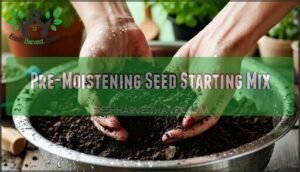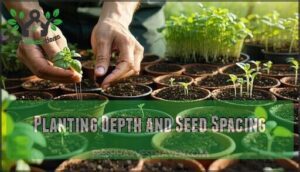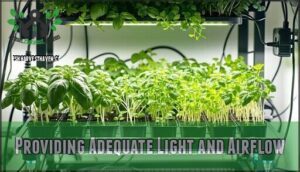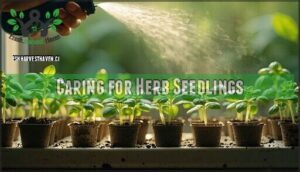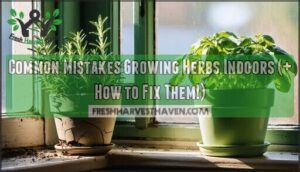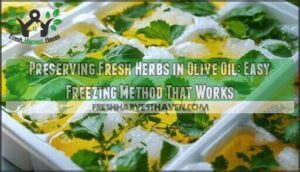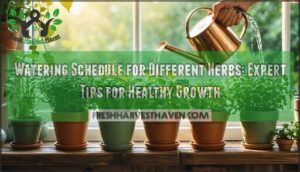This site is supported by our readers. We may earn a commission, at no cost to you, if you purchase through links.
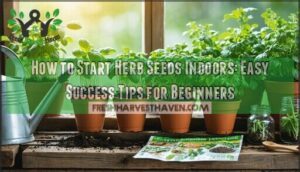 Learning how to start herb seeds indoors gives you fresh herbs year-round and saves money compared to buying transplants.
Learning how to start herb seeds indoors gives you fresh herbs year-round and saves money compared to buying transplants.
You’ll need seed starting mix, small containers with drainage holes, and a sunny windowsill or grow light.
Plant seeds at twice their diameter depth in pre-moistened soil. Basil, cilantro, and oregano germinate easily indoors, while parsley takes patience—sometimes two weeks to sprout.
Keep soil consistently moist but not soggy, and maintain temperatures around 65-75°F. Once seedlings develop their second set of leaves, they’re ready for stronger light.
The secret lies in timing your planting and understanding each herb’s unique germination requirements.
Table Of Contents
- Key Takeaways
- Starting Herb Seeds
- How to Start Herb Seeds
- Preparing Seed Starting Mix
- Indoor Seed Starting Techniques
- Caring for Herb Seedlings
- Frequently Asked Questions (FAQs)
- Can you grow herbs from seed indoors?
- How do you plant herbs indoors?
- How do I start herbs from seed?
- How do you start herb seeds indoors?
- How do you grow a herb garden?
- How to make an indoor herb garden?
- How to start indoor herbs from seed?
- Do herb seeds need to be soaked before planting?
- What herbs should not be grown indoors?
- What is the best way to start seeds indoors?
- Conclusion
Key Takeaways
- You’ll save money by starting herb seeds indoors instead of buying expensive transplants – a single seed packet costs pennies compared to $4+ per plant at nurseries.
- Plant your seeds at twice their diameter depth in pre-moistened seed starting mix, and maintain soil temperatures between 65-75°F for optimal germination rates.
- Provide 12-16 hours of bright light daily once seedlings emerge, positioning grow lights 2-3 inches above plants to prevent leggy growth and ensure healthy development.
- Gradually harden off your seedlings by increasing outdoor exposure time over seven days before transplanting, starting with just one hour daily to prevent transplant shock.
Starting Herb Seeds
Starting herb seeds indoors gives you control over your growing conditions while saving money compared to buying expensive seedlings from the store.
You’ll get access to more herb varieties and can guarantee your plants grow without synthetic chemicals from the very beginning, which is a key factor in maintaining control over your growing conditions.
Benefits of Growing Herbs From Seed
Starting herbs indoors from seed offers impressive cost savings compared to buying seedlings.
Skip the expensive nursery runs—your windowsill becomes a money-saving herb factory with just a packet of seeds.
You’ll gain organic control over your plants from day one, avoiding unwanted chemicals.
Seed starting opens up variety choice that nurseries can’t match—think purple basil or lemon thyme.
This chemical reduction approach creates healthier herbs while providing affordable seedling alternatives for your indoor garden.
Choosing The Right Herbs for Indoor Gardens
When selecting herb varieties for your indoor garden, consider your culinary preferences first.
Basil, mint, and chives are among the best herbs to grow indoors due to their adaptability and low maintenance needs.
These herb seeds indoors thrive with minimal space constraints while offering excellent flavor.
Well-draining soil is essential for healthy growth.
Match your herb selection to light requirements—Mediterranean varieties like rosemary need more sun than parsley, ensuring a successful and low maintenance indoor garden with the right culinary preferences.
Essential Supplies for Starting Seeds Indoors
Before diving into herb seed starting, gather your essential supplies to set yourself up for success.
You’ll need quality herb seeds from seed catalogs, seed trays with drainage holes, plant markers for organization, and a sterile starting mix.
Don’t forget humidity domes to maintain moisture levels—they’re game-changers for consistent germination when starting herb seeds indoors.
Consider that winter sowing mimics natural conditions for germination.
How to Start Herb Seeds
Now that you’ve got your supplies ready, let’s walk through the actual process of starting seeds indoors. The key to successful herb germination starts with understanding your seeds’ needs and creating the right environment for them to thrive.
Here’s your step-by-step approach to germinate herb seeds:
- Check seed viability by reviewing the packet’s expiration date – fresh seeds have better germination rates than older ones
- Choose proper container selection with drainage holes and adequate depth for root development
- Plant at correct depth following the rule of twice the seed’s thickness for ideal sprouting
- Maintain consistent watering frequency keeping soil moist but not waterlogged to prevent damping off
Temperature control plays a huge role in herb seed starting success. Most herbs prefer soil temperatures between 65-75°F for germination. You’ll also want to keep pest control in mind, as young seedlings can attract fungus gnats and other unwanted visitors in your indoor growing space.
Preparing Seed Starting Mix
You’ll need to get your seed starting mix ready before you can plant your herb seeds successfully.
The right preparation means mixing the soil with water until it feels like a damp sponge and making sure it’s clean enough to give your seeds the best chance to grow.
Types of Soil for Herb Growing
Your herb seeds need the right foundation to thrive. Well-drained, sandy loam works best for seed starting mix, with soil pH between 6-7.
Skip heavy clay soils that waterlog roots. For containers, premium potting soil beats garden dirt every time.
Mix topsoil, compost, and sand for nutrient-rich germination. Proper drainage importance can’t be overstated—soggy seeds won’t sprout.
For ideal growth, remember to use well-draining soil and maintain a well-draining environment, ensuring your seeds receive the best conditions for optimal development.
Pre-Moistening Seed Starting Mix
Pre-moistening your seed starting mix prevents dry pockets that reject water later.
Mix it with clean water in a large container until it feels like a wrung-out sponge – damp but not dripping.
This even moisture consistency helps seeds germinate uniformly.
Proper water quality matters too; avoid chlorinated tap water when possible.
Your mix should hold together when squeezed but crumble easily.
Sterilizing Seed Soil Mix
Once your seed starting mix feels just right, you’ll want to eliminate harmful pathogens that could doom your seedlings.
Sterilization methods like microwaving damp soil for 90 seconds per 2 pounds work perfectly for pathogen elimination while preserving beneficial microbes.
For ideal growth, consider that proper soil structure is also essential for seedlings.
Here’s why sterilizing matters for successful germination:
- Prevents damping off disease – that heartbreaking moment when healthy seedlings suddenly collapse and rot at soil level
- Eliminates fungal spores – those invisible enemies lurking in untreated mix, waiting to attack vulnerable young roots
- Creates clean slate conditions – giving your herb seeds the sterile environment they need to thrive from day one
Commercial options come pre-sterilized, but homemade sterilizers using microwaves, pressure cookers, or boiling water give you control over your seed starting tips and starting seeds indoors success.
Indoor Seed Starting Techniques
Once you’ve prepared your seed starting mix, you’ll need to master the key techniques that turn tiny seeds into thriving herb seedlings.
Proper planting depth, strategic soaking, and the right light conditions make the difference between success and disappointment in your indoor herb garden.
Planting Depth and Seed Spacing
Your seed starting success hinges on getting the planting depth just right.
Plant seeds at twice their thickness—tiny basil seeds need barely any covering, while larger cilantro seeds go deeper.
Proper depth guarantees proper germination without burying seeds too deep.
For seed spacing, sow five seeds per container to account for failures.
Proper seed density prevents overcrowding and guarantees healthy seedlings you’ll thin later.
Soaking Seeds Before Planting
Soaking certain seeds gives you a germination boost by softening their outer shell.
Focus on herb-specific needs when starting seeds indoors – basil, chives, cilantro, dill, and parsley benefit from 12-24 hour seed hydration in room temperature water.
Skip soaking for basil varieties, as they’ll get mushy.
To prevent issues, consider using a well-draining seed starting mix.
This simple seed sowing trick speeds up your seed starting mix results substantially, providing a significant advantage with proper room temperature water.
Providing Adequate Light and Airflow
Once your seeds sprout, they’ll need 12-16 hours of bright light daily to prevent leggy seedlings.
Position grow lights 2-3 inches above seedlings, adjusting height as they grow. Many gardeners find grow lights are essential for healthy seedlings.
Proper air circulation prevents mold and damping off—use a small fan on low speed. Adequate seedling spacing also improves airflow around each plant, creating healthier conditions for your indoor herb garden.
Caring for Herb Seedlings
Once your herb seeds have sprouted, you’ll need to watch them closely like a protective parent, monitoring for common problems like damping off disease and leggy growth.
Your seedlings require careful attention to watering schedules, proper lighting, and gradual preparation for their eventual move outdoors.
Hardening Off and Transplanting
Your seedlings need a gradual introduction to outdoor life before transplanting.
Start the hardening process gently—your tender seedlings aren’t ready for nature’s full intensity just yet.
Start hardening off by placing them outside for one hour daily, gradually increasing exposure over seven days.
This outdoor acclimation prevents transplant shock when you move them permanently.
Consider using a convenient hardening rack to streamline this process.
Check soil temperature reaches 60°F before final transplanting.
Strong root development during this process guarantees healthy herb gardens that’ll thrive outdoors, ensuring a successful transition with minimal stress.
Monitoring for Damping Off and Legginess
Your seedling’s health depends on spotting trouble early.
Watch for damping off—a soil-borne fungal infection with no cure—and leggy seedlings caused by inadequate light or overwatering.
Prevention checklist:
- Verify proper airflow around containers
- Provide 12-16 hours of bright light daily
- Avoid overwatering or overcrowded spacing
- Maintain moderate soil temperatures
- Remove affected plants immediately to prevent spread
Adjusting to Outdoor Conditions and Temperature Fluctuations
Once your herb seedlings show strong growth, gradual acclimation becomes your next mission.
Start hardening off by placing containers outside for two hours daily, increasing exposure time gradually. Monitor temperature fluctuations and provide wind protection during initial outdoor transplanting periods.
Adjust your watering schedule as sunlight exposure increases. Consider mulching for protection against unexpected cold snaps.
This careful temperature monitoring guarantees your seed starting efforts shift successfully from indoor germination to thriving outdoor plants, and this approach confirms your seedlings will flourish.
Frequently Asked Questions (FAQs)
Can you grow herbs from seed indoors?
You’ll discover indoor herb gardening isn’t rocket science.
Yes, you can absolutely grow herbs from seed indoors with proper light, moisture, and patience.
Start seeds 6-8 weeks before transplanting outdoors for best results.
How do you plant herbs indoors?
Fill containers with pre-moistened seed starting mix, plant seeds at twice their depth, label each variety, and place under grow lights. You’ll need consistent moisture and warmth for successful germination.
How do I start herbs from seed?
Starting herb seeds transforms your windowsill into a miniature farm!
You’ll pre-moisten seed-starting mix, plant seeds twice their thickness deep, maintain 60-70°F temperatures, provide daily moisture, and watch magic happen in 7-14 days.
How do you start herb seeds indoors?
Pre-moisten seed starting mix until it feels like wet sand.
Fill 4-inch containers with drainage holes, plant seeds at twice their thickness depth.
Place under grow lights for 12-16 hours daily.
How do you grow a herb garden?
Gardens are overwhelming," you think? Not herb gardens.
Choose easy herbs like basil and thyme. Plant in well-draining soil with 4-6 hours sunlight.
Water regularly but don’t drown them. Harvest frequently to encourage growth.
How to make an indoor herb garden?
Choose easy herbs like basil, parsley, and thyme.
Place containers near south-facing windows for 4-6 hours of sunlight daily.
Use well-draining potting mix and water when soil feels dry to touch.
How to start indoor herbs from seed?
Fill containers with pre-moistened seed starting mix, plant seeds at twice their thickness depth, cover with humidity dome, and provide 12-16 hours of light daily until germination occurs.
Do herb seeds need to be soaked before planting?
Most herb seeds don’t require soaking, but it can speed germination for slower varieties.
Soak seeds like oregano or rosemary for 12-24 hours before planting to jumpstart the process and improve your success rate.
What herbs should not be grown indoors?
Large herbs like rosemary and bay laurel aren’t ideal indoors due to their size.
Dill and fennel need deep roots and space.
Cilantro bolts quickly indoors, making it challenging for continuous harvests.
What is the best way to start seeds indoors?
Pre-moisten your seed starting mix until it’s like wet sand, then fill 4-inch containers with drainage holes.
Plant seeds at twice their thickness depth, label everything, and maintain consistent moisture under grow lights.
Conclusion
Sarah started with store-bought basil transplants that cost $4 each, but now she grows dozens of herb plants for pennies per packet.
Starting herb seeds indoors transforms your kitchen garden from expensive to economical.
You’ve learned the essential steps: proper soil preparation, correct planting depth, consistent moisture, and adequate lighting.
Remember that patience pays off—some herbs take weeks to germinate.
With these proven techniques, you’ll soon harvest fresh herbs year-round while saving money and enjoying the satisfaction of growing from seed, which is a highly economical approach.



